Blooms and bureaucracy imperil the University of Florida’s landmark campus lake.
Every morning Kim Tanzer laces up her cross trainers, leaves her Golfview home and gravitates toward Lake Alice, her favorite water body a mere five minutes away. She has taken the same route for 30 years. The ritual soothes her.
She normally spots families of soft-shell turtles and American alligator hatchlings. Laurel oaks and palmetto bushes reflect on the surface like glass.
But on a late spring day in 2021, her worries rose in tandem with the temperature.
As Tanzer trekked the shores of the lake on the University of Florida campus, the 10 acres of open water appeared pea green. May had brought welcome sunlight and warmth, but also amplified the likelihood of algae infestation. Tanzer pitied the largemouth bass beneath the gunk; the great blue herons trying to hunt above it.
The sight Tanzer cherished as both a neighbor of the lake and a retired faculty member was more soiled than she’d ever seen it. Muck coated the top and turned Lake Alice opaque.
The lake connects to Florida’s drinking water, too. To prevent the lake from flooding, two injection wells pipe water directly into the Floridan Aquifer, the region’s primary water source.
Tanzer had to act. It is unlike her to sit idly by. She is more than just another morning jogger on the lake’s trails; she is a stakeholder in its future. Tanzer helped found Alice’s Friends, a defunct advocacy group that in the 1990s defeated a massive student housing complex at the water’s edge.
The Friends beat that threat, but now the tainted water is somehow more disturbing. Generation after generation of advocates and scientists have worked to protect Lake Alice. The need for vigilance remains constant. No single administrative unit of the flagship university is tasked with caring for its signature water body.
Tanzer paused her morning walk and sent a panicked email to Linda Dixon, the university’s director of Planning, Design and Construction: “Is anyone at UF watching Lake Alice?”
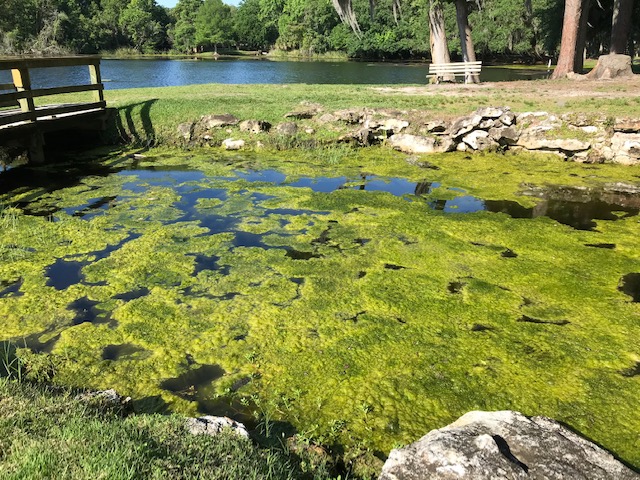
Dixon had no answer. Unsure, she connected Tanzer to Gail Hansen, chair of the university’s Lakes, Vegetation and Landscaping Committee and an associate professor in sustainable landscape design. Hansen had no answer, either.
The committee is “responsible for items that affect the use of the University lakes,” but has no power to test campus waters. Doing so requires a bureaucratic wrangle with little room for individual accountability. The last official testing of campus water bodies took place eight years ago — not recent enough to shed light on recent harmful blooms.
By summer, Hansen’s inbox filled with other concerned emails. Almost the entire lake was covered in algae. “I’ve been on campus for quite a while and I can tell you that it’s the worst that I’ve ever seen,” she says, “and it’s the most prolonged algae bloom that we’ve had.”
That June, Hansen says, she advised Matthew Williams, director of the university’s Office of Sustainability, to create a council to manage and monitor Lake Alice. More than a year later, Williams says his office is still deciding who the team ought to include.
“Campus lands are owned by the campus as a whole,” Williams says. “It’s no one particular department or unit that is responsible for them.”
Despite UF’s considerable expertise, including its Water Institute with more than 300 faculty members devoted to freshwater challenges, no one oversees campus freshwaters. Campus conservation areas have their own, unique ecological standards and management goals, but no full-time staff dedicated to meeting them.
The Florida Department of Environmental Protection’s (DEP’s) Division of State Lands owns Lake Alice and other natural areas across the state. The watershed is to be safeguarded as an educational resource. But historically, the state and its flagship university treated the lake as more of a dumping ground than a campus jewel.
From a place of respect, to the noose of a loop road
Lake Alice has drawn admirers since long before university students picnicked and hammocked on its shores. Before permits and paperwork, there were other means of preserving the land’s history.
The Alachua Tradition People, ancestors of the Potano Tribe, settled near what was a much smaller natural lake roughly 1,100 years ago for easy access to water. Another factor made the site sacred to the Tradition People: traces of life belonging to those before them, proof their ancestors once walked the same ground.
They built a burial mound about 100 yards west of what is now the Levin College of Law. Inside were human remains, pieces of pottery and a hearth. Some of the artifacts dated to the Deptford Culture, a separate indigenous community that existed another 1,000 years before the mound.
“I think it was very common for people in the ancient past to use artifacts of their predecessors to write their own histories,” says UF archeology professor Kenneth Sassaman.
Life beside the lake became a way for communities to discover and preserve their indigenous culture; the proximity to water a means of honoring ancestors. Sassaman says Native Americans largely considered lakes and other bodies of water portals to the underworld. A lake’s depths, a place of respect.
Modern Floridians transformed the lake for utilitarian purposes. Now that respect ebbs and flows.
“If you treat the lake as manmade, if you consider it to be a manmade feature in the landscape, it seems to be warrant for doing whatever you want with it,” Sassaman says.
By the 19th century, farmers called the water Jonas’s Pond. Lore suggests a man, Jonas, walked across the fields in darkness one night. He might have listened to cicadas or crickets before the ground beneath him gasped open. A sinkhole formed in all its spontaneity; the portal swallowed Jonas and sent him down to the aquifer, belly of the state.
Local legend has it that a succeeding owner, Mr. Witt, used the depression as a dumping ground for agricultural waste. He claimed dominion over 10 quiet acres. He had a daughter, Alice. In 1892, a U.S. Geological Survey map named the water Lake Alice — presumably for the farmer’s daughter.
The university cemented itself in Gainesville 13 years later. A likely wrinkled and retired Witt sold his pond and surrounding acreage to the state in 1925 for an agricultural experiment station. Instead, it became the university’s wildlife sanctuary.
The stated intent to safeguard the water and its wildlife went disregarded in just two decades. The sanctuary became a wastewater pit. Campus-wide sewage choked the lake from 1946 to 1947. Outraged residents pushed the administration to redirect the waste to a nearby sinkhole. The university complied.
Now, engineers eyed Lake Alice as the campus stormwater basin. To take on that much runoff, it had to be bigger. UF dammed the earth around Lake Alice in 1948 to expand its size. Water pooled and grew the lake’s surface area until 1959, when engineers installed the two injection wells to prevent overflow. Any water that risked flooding the surrounding campus would be funneled into the aquifer.
The next year, the sewage sinkhole was full. Treated sewage again flowed directly into Lake Alice. Even chlorine could not prevent the pollutants from skyrocketing.
Water hyacinths spanned the lake from shore to shore throughout the late 1960s. The invasive plants proliferated with all the extra nutrients. Alongside bouquets of lavender-blue, their clusters of leaves spread like cancer. They robbed the submerged native wildlife of oxygen. Specks of periwinkle dotted the sea of green in an almost apologetic fashion — the petaled beauty consolation for burying life below.
Florida gar, black crappies, brown bullhead catfish and other wildlife suffocated under the vegetation. Their carcasses expelled nitrogen, already abundant in the lake from decades of sewage and agricultural waste. Additional nutrients attracted even more hyacinths. Hyacinths prompted even more fish kills.
It became difficult to see Lake Alice for what it was: a sanctuary, a rare remnant of wild Florida. It had descended into entropy.
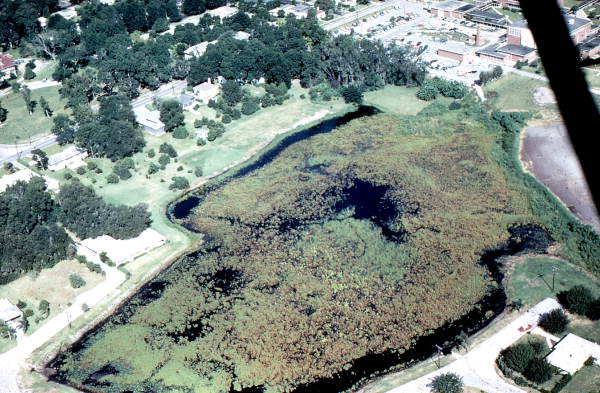
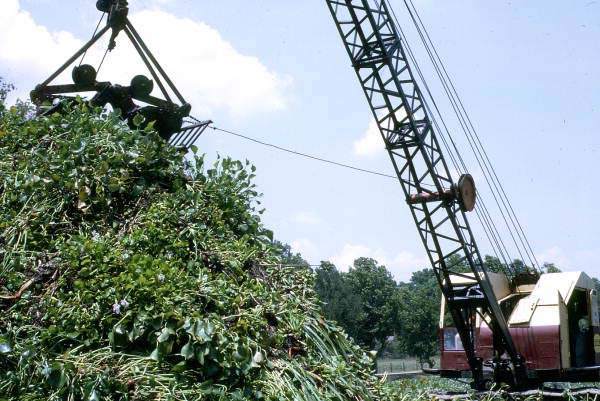
By 1969, then-UF President Stephen O’Connell announced plans to drain the lake for a $1 million project: the Cross-Campus Highway, or Lake Alice Loop Road. The Florida Department of Transportation approved construction of four asphalt traffic lanes that would corral the lake. The road was expensive for the time, but boosters claimed it would pay for itself by increasing student enrollment.
Dredges and herbicides purged the hyacinths in 1970, the year of the first Earth Day. The following year, O’Connell said Lake Alice had “very little ecology left.” Much of the native fish and plant life had perished, curbing the over 200 species of birds that relied on the watershed. Ten years before, more than 40% of Florida’s bird species had frequented Lake Alice.
Losing the rest of the lake seemed inevitable to O’Connell. The expansion and prestige of the university took priority over dwindling campus wildlife. The UF community disagreed.
A new generation of conservationists including Marjorie Harris Carr, who would also help stop the Cross-Florida Barge Canal, set out to halt the rampant pollution, mass drainage and dams harming waters across the state and nation. Reporters covered the loop road controversy in The Florida Alligator from 1969 to 1972 with dogged persistence. Students and faculty organized and rallied.
Over 80 advocates biked from Gainesville to Tallahassee in a November drizzle and chill to protest the state’s decision to build the highway. Though the road had already been approved, the state and university administration begrudgingly agreed to host a public hearing at UF’s J. Wayne Reitz Student Union on Jan. 12, 1972.
That Wednesday, the Reitz auditorium overflowed with 360 people. Hundreds more waited outside. Advocates spoke out against the road. The university defended it. Law professor Joseph Little presented a 260-foot petition with 4,397 signatures against the construction. One week later, the university agreed to analyze alternative options, namely the expansion of mass transit. The Cross-Campus Highway was dead.
Lake Alice was saved, but only for the time being.
Algae and bureaucracy, run amok
Green water is not unique to Lake Alice.
Many Florida waters have naturally high levels of nutrients. Underlying sediments, like the thick layer of clay known as the Hawthorn Formation beneath Lake Alice, contain phosphorus that becomes part of a stream, river or lake.
But human activities aggravate the problem. Fertilizers, sewage and storm runoff are the primary sources of nitrogen and phosphorus pollution in state waters.
The Clean Water Act went into effect on Oct. 18, 1972, nine months after the public hearing that saved Lake Alice from a permanent noose of traffic. Government would now constitute healthy water. To determine how standards should be met and enforced, different water bodies needed different designations.
The new rules brought about widespread improvement in water quality. They also brought widespread confusion.
A symbol of water-quality rules that can be at once absurdly bureaucratic and inadequate to keep water clean, Lake Alice is considered a conservation area—and is permitted by the St. Johns Water Management District as a stormwater pond. There are no water-quality or nutrient standards required of such retention ponds. Sewage continued to drain into the lake into the ‘90s.
The university obtained a National Pollutant Discharge Elimination System Phase II permit in 2003 to study the effects of stormwater runoff on municipalities. The program regulates institutions or companies that directly release pollutants into water bodies, with Phase II focused on educational outreach and watershed planning.
In the following decade, DEP designated the lake what is known as a “Class III water,” which requires it be healthy enough to support wildlife, including fish safe enough to eat. The university has violated that standard in two areas — for fecal coliform and E. Coli bacteria, and for exceeding phosphorus limits and keeping insufficient biological data.
Rather than rising to meet DEP’s standards, the university modified its Campus Master Plan in 2015 to “strive to meet” them. Still, UF is not required to do so — and Lake Alice remains on DEP’s Impaired Waters list.
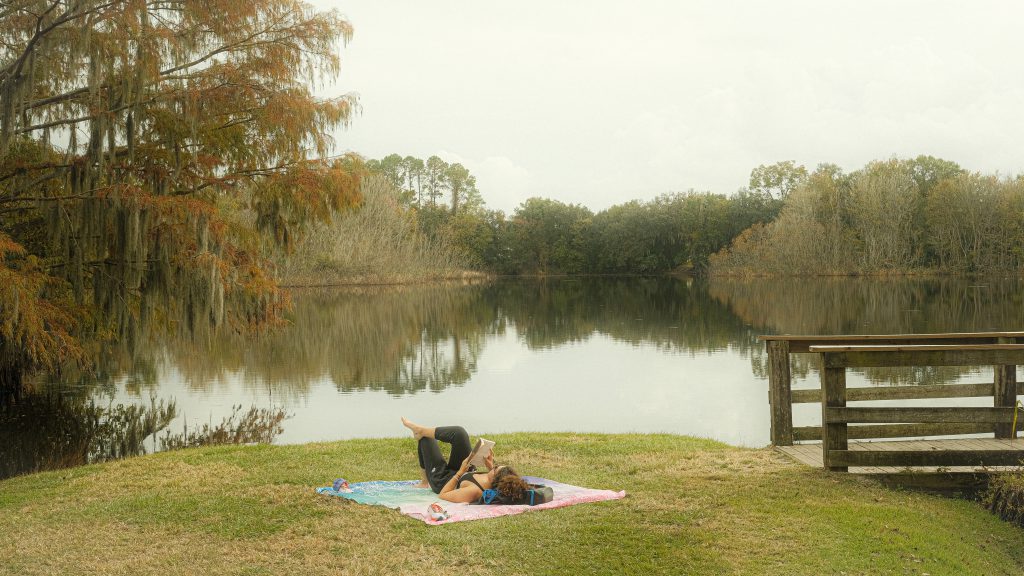
Mark Clark, an associate professor of wetland ecology, led water quality testing and outreach efforts for the university until 2014. Clark monitored nutrient levels in Lake Alice and other campus waters. He held particular interest in Lake Alice because it absorbs almost everything that hits the ground at UF. Of the 400 storm drains on campus, 77% send stormwater directly to the lake.
The most recent data show that the lake exceeds maximum safe levels of nitrogen and phosphorus. That has been the trend for more than 30 years. That hydrological history is a microcosm for the state, a testament to the ecological impacts of urbanization.
“We need to change the way we operate on the landscape,” Clark says. “But the problem is we’ve already developed a huge amount of it. It’s really hard to go backwards.”
Along with failure to regulate agricultural runoff, stormwater pollution is seen as one of the great shortcomings of the Clean Water Act. Every inch of impervious surface, from buildings to roads, worsens polluted runoff. Water cannot seep into concrete and asphalt. Instead, it slips and slides off hard surfaces into the nearest water body, picking up more contaminants on its journey.
“Many of the closest associations people have with a water body is actually a stormwater basin,” Clark says. “That connection between what’s happening here on campus and what’s happening in literally tens of thousands of stormwater basins around the state is the same.”
Across the nation, communities are recognizing the importance of nature-based solutions such as greenspace and other permeable surfaces near watersheds to clean up pollution and absorb the extreme rains associated with climate change. But UF in recent years has sought permission to pave over more land near the lake.
UF’s Stormwater Master Plan, approved by the water management district in 2010, capped the number of additional impervious areas along the watershed to 169 acres through 2020. That’s an expanse almost 17 times larger than the lake’s 10 acres of open water. The plan did not require additional stormwater catchments to lessen harm to UF’s signature lake.
As of this year, buildings, parking lots and other slabs of concrete account for more than 40% of the watershed — covering nearly 460 of the 1,106 campus acres that drain into the lake. Almost twenty major construction projects are scheduled or in progress across campus.
Before, during and after the environmental reckoning of the early 1970s, generations of university administrators kept a more watchful eye on land-development opportunities than water-quality issues. But every generation, too, has its lake-loving advocates.
Ten years of protests and petitions proved successful for Tanzer and Alice’s Friends in the late ‘90s. The group defeated an 11-building student housing complex scheduled for construction at the lake’s edge. In 1999, the university amended its campus master plan to prevent construction of housing on the site.
“We ended up achieving a victory against the University of Florida,” Tanzer says.
Now facing the global peril of rapid climate change and the biggest campus building boom in decades, a new generation of advocates for Lake Alice is needed like never before.
A return to respect, a new generation of care
Marian Azeem-Angel transferred to the University of Florida from Miami Dade College in August 2019. She felt unsure of what she wanted to study until she stumbled across Lake Alice.
The 23-year-old looked out at a murky expanse, no doubt further obscured by the heat and humidity of a Gainesville summer. She felt pity for the water.
Poor thing, Azeem-Angel thought to herself. She’s really green. She has a lot of growth.
Azeem-Angel was no stranger to murky water. South Florida is densely populated and notoriously developed. Cloudy canals and turbid ponds litter neighborhoods and golf courses. Since many waterways are human made, carved of earth for stormwater collection or a contrived view, they seldom prompt community concern when polluted.
Yet this lake is the heart of Florida’s flagship university campus, home to legions of renowned water scientists and environmentalists. She wondered: why was its most prized water body green?
Azeem-Angel ultimately majored in environmental science, minored in soil and water science and based her final undergraduate project on testing campus water bodies for heavy metals and nutrients.
“The integrity of the water quality with Alice matters, especially if it’s being considered and treated as a conservation area, because it’s not just the immediate lake,” Azeem-Angel says. “A lot of native Florida species live there. If the water quality in Lake Alice deteriorates, then that effect moves upwards to all of the species that depend on Lake Alice.”
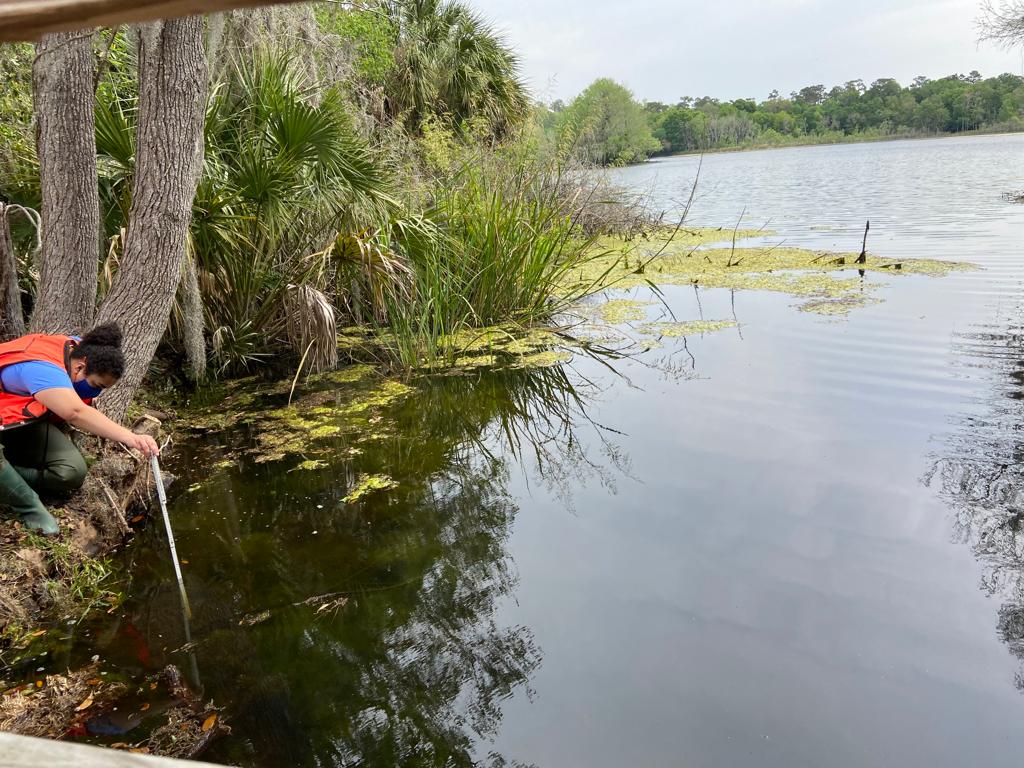
Her results are still preliminary, but they are the most recent attempt to gauge Lake Alice’s nutrient levels. The data show that ammonia levels have risen since the lake was last tested. Ammonia precedes nitrogen in the nitrogen cycle, which could suggest another nutrient uptick in the near future. More nitrogen could mean more algae.
Yet she says solutions are out there: additional stormwater basins and ponds for campus; replacing impervious surfaces with more greenspace across the watershed; using fewer of the herbicides now applied for the lake’s manicured aesthetic.
Less strain on Lake Alice would lessen the impurities flowing into the Floridan Aquifer. It would mean less pressure on the fish, birds and other animals that are residents of the watershed.
Even if she will no longer be on campus to find out, she hopes the next line of students will benefit — and advocate.
In the meantime, Azeem-Angel brings her thirst for solutions abroad. She received a Fulbright grant to study in Denmark beginning this month. There, she measures rates of nitrogen removal and water filtration across city streams — a project she pitched herself, inspired by her last project on campus waters. Inspired by Lake Alice.
This story is part of the UF College of Journalism and Communications’ series WATERSHED, an investigation into statewide water quality marking the 50th anniversary of the Clean Water Act, supported by the Pulitzer Center’s nationwide Connected Coastlines reporting initiative.
 WATERSHED
WATERSHED